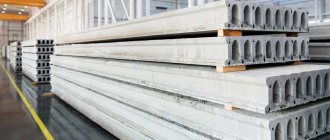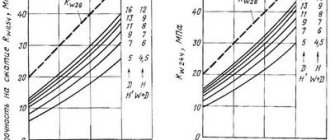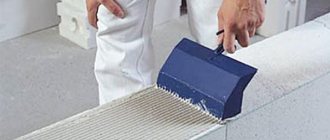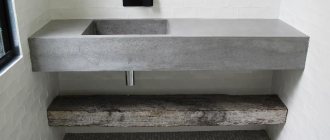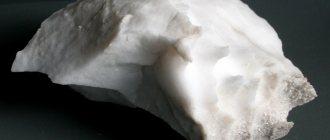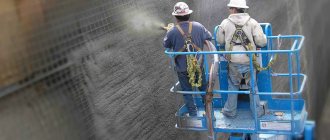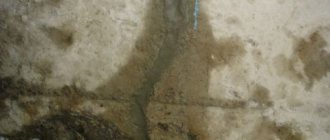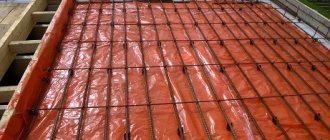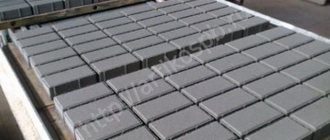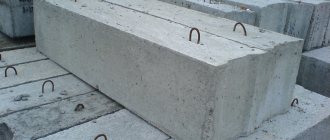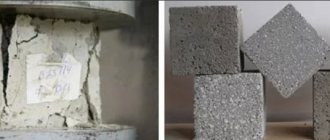Despite the fact that there are now enough companies that supply ready-made concrete, very often you have to mix it yourself. Most often, concrete is prepared by hand when you need to pour small reinforced concrete structures: screeds, stairs, paths, steps, etc. At the same time, it is very important to have sufficient knowledge regarding the technology for preparing the concrete mixture, the components used and their proportions (depending on the purpose).
Concrete composition table.
A profitable idea for entrepreneurs
Concrete has no analogues and is used in almost all private and industrial facilities. Foundations, walls, and ceilings are made from it. Paths, platforms and parking spaces are laid. So there is no shortage of demand even in small cities. The use of concrete is somewhat related to seasonality. With the onset of the active construction period, its use increases significantly.
In our market, concrete production is mainly carried out by large industrial companies. However, their products are also designed for large consumers, who then resell the material to small developers and private clients. To work directly with small consumers, you can organize your own small concrete production. There are not enough existing small firms to fully satisfy demand, so it is easy to fill this niche.
Due to the lack of manufacturers who could sell the material to small developers and private owners, creating your own mini-factory for creating concrete is an excellent business idea.
Stationary concrete plants
Such concrete plants are made of several modules assembled and adjusted for operation. They are delivered to the plant site by oversized transport. The time for installation and readiness for use takes ten days, this is subject to the condition that there is a ready foundation for this equipment.
Stationary concrete batching plants have a large capacity for making concrete or concrete mixtures. Several large cement warehouses are installed at the plant, and special places are prepared for storing and receiving the initial materials from which concrete is made. The plant has a laboratory to check the quality of concrete and mortar, as well as analyze the productivity of the plant.
What equipment is needed to produce concrete?
First of all, you will need a stationary or mobile mini-plant capable of producing up to 60 cubic meters of concrete per hour. The production process must be fully automated. This way you can achieve high quality and good performance.
The advantage of mobile equipment is the ability to move work to any location. All units can be dismantled and “moved” to a new location. This will make it possible to provide any construction site with materials.
The cost of a simple concrete production plant will be about 1.5 million. If you decide to purchase a high-performance system with additional devices, the plant will cost 8-12 million.
The choice of equipment for work is influenced by the scope of its application, the type of material being created and production volumes.
Automated lines are good because they can be operated by a small number of workers. Accordingly, the number of errors and problems in work decreases. The human factor is almost completely eliminated. This is a great investment for the future. In practice, such industries can earn up to 1 million per month.
Your staff will consist of 3-4 people. In this case, employees will not need to undergo special training. This is a great advantage for the employer.
One of the stages of such production is the delivery of concrete to the customer’s site. This is a specific material, which means it will require special equipment. Concrete must be transported in a mixer. If you assemble it on the basis of a domestic Kamaz, transport will cost about 2.8 million. Imported bases will cost much more, so in the beginning it is better to do without them.
As a result, we can say that the starting costs for creating such a production will be very impressive - about 4-5 million, with a minimum set of tools and equipment. However, the payback on the project will range from several months to 1.5 years, which is generally not bad.
All about the composition
Material Components
When producing heavy concrete, you need:
- sand with particles ranging in size from 0.14 to 5 millimeters;
- crushed stone (granite, gravel, diabase or limestone) with particle sizes from 5 to 70 millimeters;
- plasticizers, hardeners and other additional necessary additives.
The amount of each component is determined by the strength class of the material. The highest class - BSG B30 - has a strength grade of M400. In this case, the volumetric mass is 2410 kilograms per cubic meter, frost resistance is 300 cycles, water resistance is the highest.
When making sand concrete, only sand is added to the mixture.
We will tell you further about how to calculate the preliminary composition of heavy cement concrete.
Calculation of the composition of heavy concrete and its design
Required data
When calculating, it is necessary to determine how much crushed stone, sand, water and cement must be added to obtain high-quality material. The resulting cement composition should be easy to lay and have the required strength. In this case, it is advisable to meet the stated deadlines, using cement (the most expensive component) to a minimum.
So, to carry out the calculation we need to know:
- the brand of concrete that should be obtained, as well as the conditions for its hardening and age;
- sand characteristics (humidity, density, particle size);
- characteristics of cement (real and bulk density, activity, grade);
- characteristics of gravel or crushed stone (real and bulk density, particle size, total number of voids, aggregate moisture content);
- the ability of the cement mixture to be easily laid;
- the purpose and conditions of use of the resulting concrete, the type of structure, the conditions under which compaction occurs.
Methods
To calculate the concrete mixture, use one of the methods. The easiest way is to use the one that is based on the so-called “absolute volumes”. In other words, we will assume that after laying the cement mortar in the prepared form, as well as the subsequent compaction of this mixture, there are no voids.
Using this method, first make preliminary calculations using special tables. From these tables you can find out how much water is required to make one cubic meter of cement mixture. This takes into account the particle size of the fillers (the values for gravel and crushed stone are indicated separately), as well as the specified mobility (hardness) of the finished mixture.
And to make sure that the calculations are made correctly, it is necessary to conduct tests. Why make a small (test) amount of the mixture, cast samples and check whether they correspond to the required parameters. If the result is positive, the entire batch of concrete is mixed. If something doesn’t work out, you need to change the composition.
The following video talks about the calculation of heavy concrete:
Recommendations for selection
These recommendations are contained in GOST 27006-86. They were developed for the construction industry. The goal was to reduce cement consumption while maintaining the specified material characteristics.
In particular, the recommendations for the selection of heavy concrete compositions state that:
- If the resulting material, in addition to strength, must have additional properties (frost resistance, corrosion resistance, water resistance), it is worth considering that special technology and materials are selected.
- The most important parameters of the composition of heavy concrete are the volume of cement and water, the percentage of sand in the total amount of fillers, and the consumption of additives.
- For small volumes of concrete production, you can use the average data given in the tables (appendix to the recommendations). By opening the corresponding GOST, you can find these tables.
You can download a guide to selecting heavy concrete compositions here.
Below is a recipe for making your own cement mortar. To make concrete of strength grade M250 you will need:
- cement M500 (from 6 to 7 fifty-kilogram bags),
- 650 kilograms of sand with particles up to 5 millimeters,
- clean crushed stone (1.15 tons),
- water (155-180 liters).
Ingredients for making concrete
In order for the solution to obtain its properties, it is necessary to select all the components correctly. The classic set of ingredients is:
- Cement is the main component on which concrete is created. It is a gray caustic powder containing limestone. When moistened, it crystallizes and hardens.
- Coarse or fine aggregate. Performs several functions - reduces cost and gives the material the desired structure and strength. Its role is most often played by gravel or crushed stone of different origins and fractions. To obtain greater density and strength, materials with sharp and flat edges are used. The size of coarse aggregate can be 5-20 mm. It is extracted from natural sources. Instead, artificial substitutes can also be used - slag, expanded clay, etc. This makes the material cheaper, but slightly reduces the characteristics of strength and resistance to external influences. The role of fine aggregate is usually played by sand. It is extracted from quarries, since sea sand contains a lot of salt. Before use, the sand undergoes thorough cleaning so that there is no large fraction, dirt or excess impurities left in it. The grain size of sand should be from 0.6 to 2.5 mm.
- Water is an essential component of concrete. Without it, the hydration reaction and solidification of the solution are impossible. Before use, it is also cleaned to ensure that there are no impurities or salts.
Dangers of artisanal preparation of concrete solutions
The usual technology for making concrete seems simple enough to prepare independently. In fact, this process has many nuances that affect the final result. Not to mention the labor intensity of mixing concrete (the process is recognized as the most difficult when made manually), temperature conditions, thorough mixing, and the quality of the starting components are important.
When mixing components at home (in troughs, on the ground, in primitive concrete mixers), it is impossible to achieve uniform distribution of the binder, which inevitably affects the strength of individual sections of concrete.
The use of unsifted sand containing mechanical impurities (dust, clay, sulfates) also affects the strength and leads to rusting of reinforced concrete reinforcement. Corrosion processes are accelerated by the use of rusty, untreated water.
The average builder of a country house does not have the opportunity to check the composition of the cement for compliance with the declared brand, or to weigh the components of the mixture to ensure compliance with the recipe. Dosing in buckets does not ensure the correct composition of the concrete solution.
These dangers can be avoided by ordering pre-mixed concrete. In the industrial production of concrete, sifted sands, selected crushed stone, purified water, and proven Portland cements are used. Automatic dosing using dispensers, thorough mixing with powerful mechanisms ensure the correct composition and high quality of the concrete solution. Delivery of ready-made concrete by concrete trucks is carried out on time, facilitating suburban construction.
Tips for concrete production
There are several requirements for creating a solution, fulfilling which will make it possible to create a reliable material that will fully satisfy customer requirements:
- The mixture recipe should never be violated. All ingredients must be dosed strictly.
- Mixing the solution must be thorough. It is necessary that the resulting mixture be as homogeneous as possible.
- The amount of water may vary depending on the remaining raw materials.
- The main component is cement. It must be of the highest quality, then the entire product will turn out good.
Factory equipment
Large factories for the production of concrete mortar use concrete mixers operating continuously or periodically. The principle of operation of concrete mixers with a batch process is based on loading the required doses of components, mixing and excavation. Continuous concrete mixers operate on an ongoing basis.
To obtain highly rigid mixtures, factory production uses vibrating mixers based on mixing and vibration.
The meaning of vibration is that with special settings, the adhesive bonds between the components of the mixture are disrupted. As a result, the mobility of mixing the solution increases due to the resulting suspension.
Modernly equipped plants add “mixing plus heating” technology, adding hot steam (up to 60 °C) to the concrete mixer, which is more effective than electric heating or hot water.
Opening a concrete production plant: step-by-step plan
Such a business involves the following steps:
- drawing up a competent business plan;
- company registration (as already mentioned - LLC form)
- searching for a suitable building for production or construction from scratch;
- purchase of necessary equipment;
- purchase of the first batch of raw materials;
- search for customers;
- hiring.
If there are quarries for the extraction of crushed stone or sand in the region, you will be able to save on logistics. It is better to build a plant near these places. Otherwise, look for suppliers of raw materials who provide discounts for volumes or regularity of purchases.
Cuboid crushed stone and sand
In the Russian Federation, the production of concrete with cube-shaped aggregates is a new product. The technology was first used in St. Petersburg. Due to its cubic shape, crushed stone forms a tight connection, reduces cement consumption and increases density. The first samples have proven themselves well in road construction.
The situation with cube-shaped sand is similar, but the pioneer was an enterprise in the Primorsky Territory. Today they have the only installation for the production of such sand, which was purchased in Japan.
